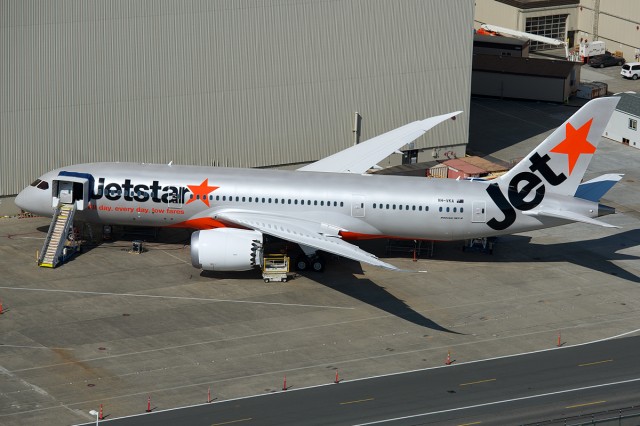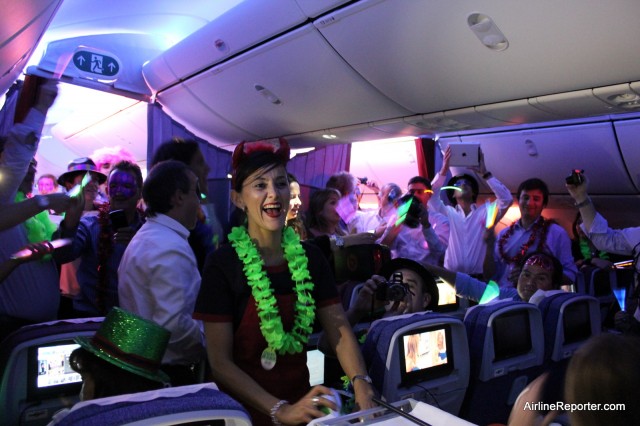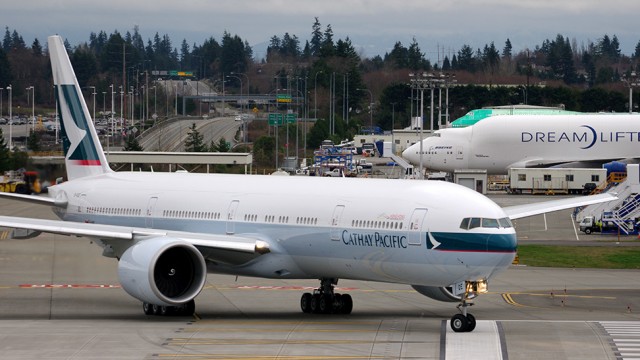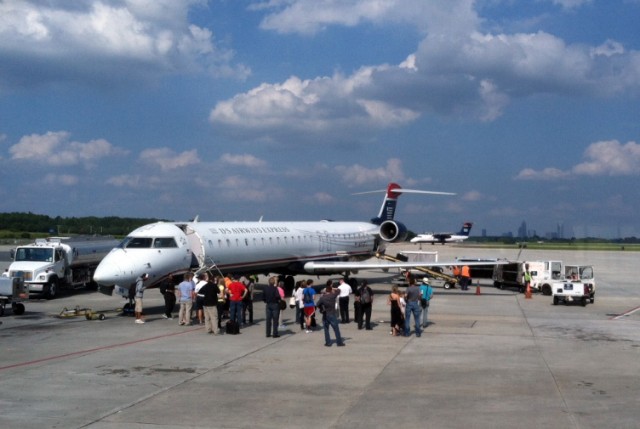
Jetstar’s first Boeing 787 Dreamliner (VH-VKA) sits at Paine Field earlier today. Photo by Bernie Leighton.
Last weekend, the first of 14 Boeing 787 Dreamliners for the Qantas Group rolled out of the paint hangar at Paine Field. This aircraft will be heading to Jetstar Airways, a Qantas-offshoot low cost carrier (LCC). The delivery will be significant, since as of now Jetstar operates an all-Airbus fleet.
Jetstar currently operates the A320-family on short-haul routes around Australia, the South Pacific, and Asia, while running larger A330-200s on long-haul routes from Australia to Asia & Hawaii. The A330s are a mix of new aircraft and ex-Qantas birds. As the airline receives new 787s, they plan to transition their newer A330s into the legacy Qantas fleet.
Despite this being the first for Jetstar, Boeing has delivered over 100 aircraft to the Qantas Group, ranging from the original 707 up to the 747-400ER (of which they are the only operator of the passenger variant).

An AeroGal Boeing 767-300ER. Photo courtesy of Joe McBride, Kansas City Aviation Department.
I’ll be the first to admit it, I absolutely despise Eurowhite liveries. Unfamiliar with Eurowhite? The term refers to an all/mostly white plane with a bit of decoration here and there.
A Eurowhite livery is cheap, boring, uninspired and a huge loss from a branding and brand recognition perspective. Be that as it may, it’s a trend that started in Europe and quickly spread across the world. But not all is lost, let’s examine an airline that managed to take a boring concept and spruce it up a bit. Never thought I’d say it, but this is a Eurowhite livery that I’m a fan of.

A party erupts during LAN’s first 787 delivery flight.
This is my favorite photo that I have taken. Maybe not the “best,” but my favorite because it tells a story. It was taken during LAN’s 787 delivery flight. After the meal service, it seemed like people were about to settle down and go to sleep. Instead, those LEDs went into “rainbow mode” and music starting going through the cabin.
Employees from the back of the plane came forward in costumes and handed out glow sticks, leis, hats and more. Everyone started singing in Spanish (a language I do not know), but it did not matter. This was truly one of the most amazing moments reporting for AirlineReporter.com and this is my favorite AvGeek photo.
Do you have a favorite AvGeek photo? Email it on over to me to da***@*************er.com with a short description (about 100 words or less) on why this is your favorite photo. I might end up using it in a future story or for the #AvGeek Photo of the Week on Twitter and Facebook.

A Cathay Pacific Boeing 777-300ER preparing for a Test flight at Boeing’s Everett Factory. Image: Mal Muir.
If you need to travel between New York and the Canadian west coast, there are just a few choices. Your main options are Air Canada or WestJet, which both operate direct flights between New York and Vancouver. Another option is flying a US-based airline (like United or American) via one of their hub cities. But what if you have a nice chunk of points to burn and want to get the best bang for your buck? Sure, you could redeem for Air Canada business, but that would just be like flying any other US airline in the front cabin. What if you could get a truly unique experience for the same amount of points as any other redemption? Well you can, with an unexpected airline.
Cathay Pacific Airlines (CX), based in Hong Kong, operates four daily flights between New York’s JFK Airport and Hong Kong’s Chek Lap Kok Airport. However, one of those flights has a layover in Vancouver. The last flight of the day (CX889) makes a stop along the way and Cathay Pacific has “Fifth Freedom” rights between New York and Vancouver.
What is a Fifth Freedom flight? It’s where an airline is allowed to sell tickets on a flight between two foreign countries as part of a service connecting their own country. Confusing, right? In layman’s terms it means that if, for instance, the airline needs to make a fuel stop mid-route or something similar, then it can sell a ticket from that stopping point to the end destination.
Cathay Pacific’s flight from New York to Vancouver is unique in that those in premium cabins get all the standard international service items, despite the fact that it’s only a five-hour flight. So even though I was flying a transcontinental flight JFK-YVR, I still got the multiple-course meal, amenity kit, and even pajamas. All the standard items you would get as though you were flying Cathay Pacific for a 14-hour flight.

People picking up their bags. Photo by Andrew Vane.
This Story was Written by Andrew Vane for AirlineReporter.com:
Although not filled with the glory of a wide-body international flight typically experienced by others, any opportunity to fly commercially always brings a smile to my face. Getting to fly, no matter the distance or aircraft, is what being an #AvGeek is all about! To quote a childrens book titled ’œRailroad Toad’ by Susan Schade and John Buller (that I used to read to my children): ’œGive me a ticket to anywhere, the farther the better I don’t care!’
Well, that opportunity rolled around again for me. This time, I got to fly for business from my home city of Charlotte, North Carolina to the capital of Pennsylvania, Harrisburg. Up one afternoon and back the next is all I had time for with this trip.
To give you some background on Charlotte-Douglas International Airport (CLT), in 2012 it was the eighth-busiest airport in the US and had more domestic flights than New York’s LaGuardia and Kennedy combined. As a major hub to US Airways (soon to become American Airlines), the airport has grown from three small crisscrossing runways in the 1960’s to four long runways capable of handling an A340-600 or Boeing 777. CLT officials are also planning to give the longest runway a 2,000 foot extension at some point in the future. Hmmmm. My last fortune cookie said ’œI see big things in your future’ so perhaps someday an A380 will grace CLT.




